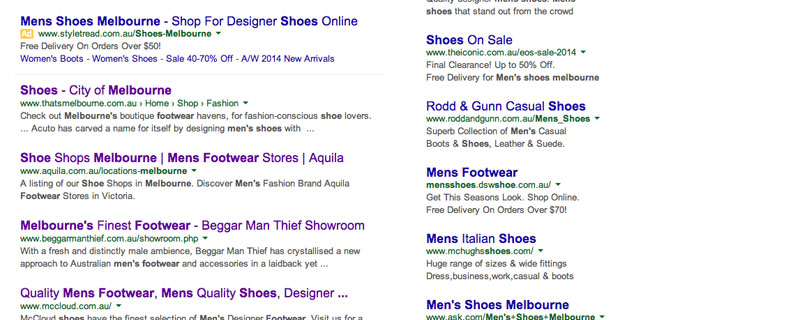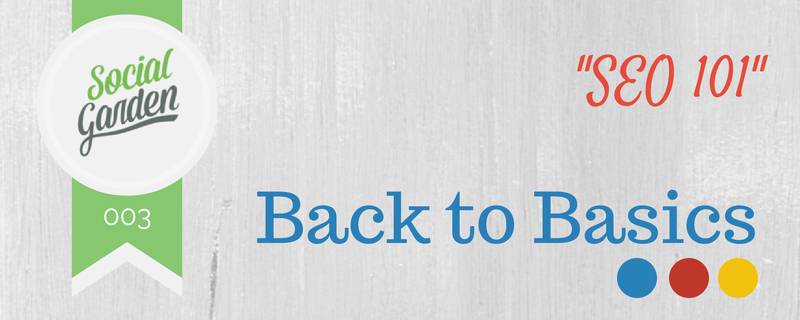BLOG
Back to Basics: What is Search Engine Optimisation?
Search engine optimisation (better known as SEO)–whether you’re new to the concept or consider yourself a digital marketing expert, a lot of people still struggle with the concept of SEO, what it means and what the best ways are to go about optimising your webpage.
So we’re here to set the record straight once and for all. Here is our SEO breakdown.
So what is Search Engine Optimisation really?
The simple definition of SEO is this: SEO is the process of boosting the visibility of a website in a search engine’s organic (also called natural or un-paid) search results.
Basically, it means how high your business website ranks on a Google, Yahoo or Bing search when consumers are searching for your product or service. The search engines rank all of the related web pages, videos, local listings and other content that they think are most relevant to the keywords used to search. They base their results off a unique algorithm that take several factors into account, which we will get into a bit later.
This does not include paid ads. This comes from average people looking for “men’s shoes, Melbourne” or “top cafes, Sydney.”

What’s in the algorithm?
A search result’s algorithm sets a standard or a list of criteria that must be met in order for a website to rank higher in the search results. As a website meets more and more of these demands, they’ll be ranked higher.
The reason this algorithm is set is because search engines want to discourage spam and other sales content from overtaking quality information and research that users might be searching for. It stops blogs and other creative content from being bogged down by ads and sales websites, giving quality content a chance to be seen by more eyes.
Search engines factor in features of your website’s actual page as well as its reputation around the web, more commonly called “on-the-page” and “off-the-page.” Let’s go through features of both.
On-page SEO criteria
In order for your site to be pushed to the top, or at least the first page, of the search results, there are several features your site should have to make it stand out above the rest.
First, you need quality, substantial content. Whether you’re a lawyer with your own private practice or a jewellery designer, each page of your site should have good copy, at least 300 words or more, that states a purpose or gives the reader some sort of information. The content shouldn’t be overstuffed with keywords, but there should be a few keywords pertaining to your business sprinkled throughout your content.
Google, and many other search engines, reward sites that are updated with new content often so many businesses keep a blog so their site is updated more frequently. [twittee tweet=”Blog content should be fresh and relevant to your industry. #blogging #contentmarketing @mikejamesbird” content=”Blog content should be fresh and relevant to your industry” balloon=”Click link to Tweet!” position=”topMiddle” theme=”light” id=”sg01″ ] and time (so don’t write about Christmas jewellery in May), and each post should be thoroughly researched and have a few related links embedded in the text.
The HTML titles and meta description tags should also be relevant to your business and the content on your website. The titles of your pages and any headlines or subhead lines should all have keywords interwoven into the text. For example, jewellery designers should be targeting words like “jewellery,” “necklaces,” “earrings,” “bracelets,” “silver” and “gold” and putting them into titles and headlines.

MDT Design uses keywords in their page titles.
[twittee tweet=”Moderation is key here. Again, you don\’t want to overstuff #keywords. #seo #contentmarketing @mikejamesbird” content=”Moderation is key here. Again, you don’t want to overstuff keywords.” balloon=”Click link to Tweet!” position=”topMiddle” theme=”light” id=”sg02″ ] Your viewers will question the credibility of a site that has no real content or appears to be trying too hard to fit in a few extra keywords. Let the keywords come in naturally.
The architecture of the site itself can drastically change how high your website will rank. A site that is difficult to navigate and cannot be “crawled” or catalogued effectively will not be pushed up. Similarly, if your site doesn’t load quickly enough, meaning it’s laden down with photos or is designed in Flash, it won’t get very high either.
A responsive design, meaning one website designed to appear on all types of media devices (computers, smartphones, tablets, ect.), is also favoured by search engines. Google and other sites reward websites that only need to be catalogued once, instead of having separate versions of the same website for each type of device.
Off-page SEO factors
These types of search engine optimisation factors don’t have to do with the actual webpage itself. It’s more about how the page is perceived on the Internet, and a bad reputation can sink your webpage into the depths of search results.
Having a healthy link profile here is vital. A link profile is made up of all the sites where your website actually appears. For example, if someone posts a blog with a link to your website, that’s an addition to your link profile. The goal is to get-highly reputable websites to link back to your website. This will pull you higher up the search results page.
You want to avoid paying for purchased links and spamming blogs and forums with your website. These websites have poor reputations with search engines and will only hurt your reputation.
It has often been said that those who lie with dogs get flees. The same could be said about search engine optimisation. If your content quotes come from spam websites or the facts you state in your blog come from unreliable, sketchy sources, then you can’t expect your site to rank high in search results. It’s also important to maintain your identity. If you’re representing yourself, say so. If you’re impersonating someone (like God or Lord Voldermort), just say so. Google appreciates honesty and authenticity, even if it’s just for a laugh.

Whatever you do, do not post any pirated content. Make sure any videos or images have a source cited underneath them. Pirated content is automatically pushed lower in search engine optimisation.
Having social media helps here as well. Not only do you have a safe group of sites to build up a link profile with, but you also have a chance to build and maintain a reputation. All of the content on your website’s blog can be shared through Facebook posts and Twitter tweets. Your followers will then come to your site and hopefully repost your links on their own social media accounts.
These content shares boost search engine optimisation as well. Google especially favours pages that have been shared on social media sites. Your followers can do a good bit of marketing for you if you can only get them to repost and share your content.
As you can see, search engine optimisation is anything but simple. It’s process that takes time, strategic planning and design. In the race to the top of Google search results, only those that incorporate all aspects of search engine optimisation shall be victorious. Are you up to the challenge?











